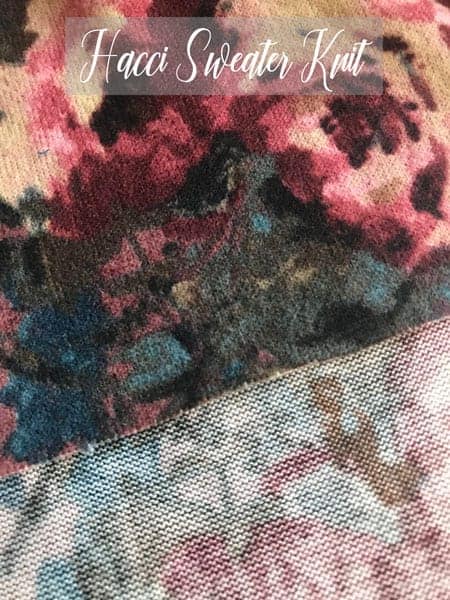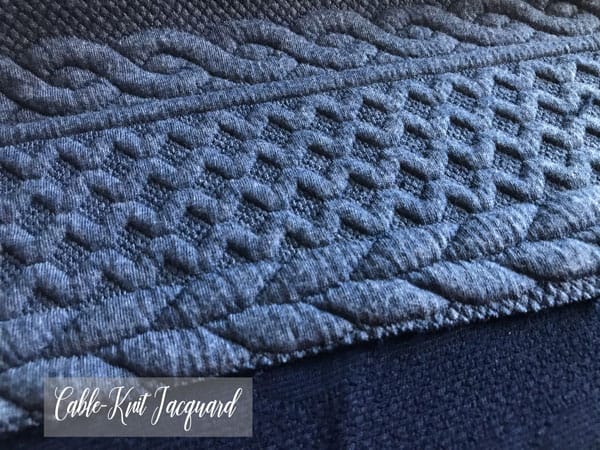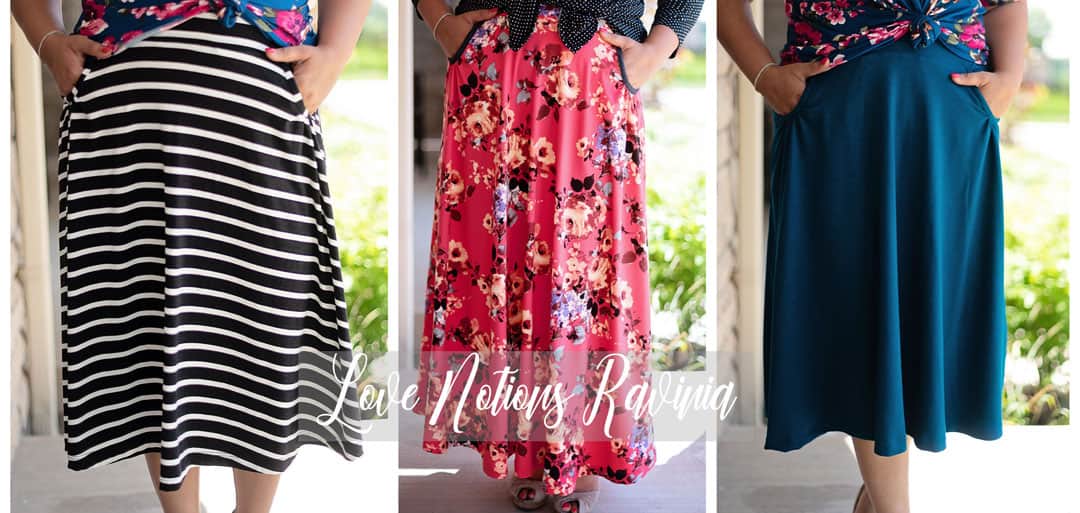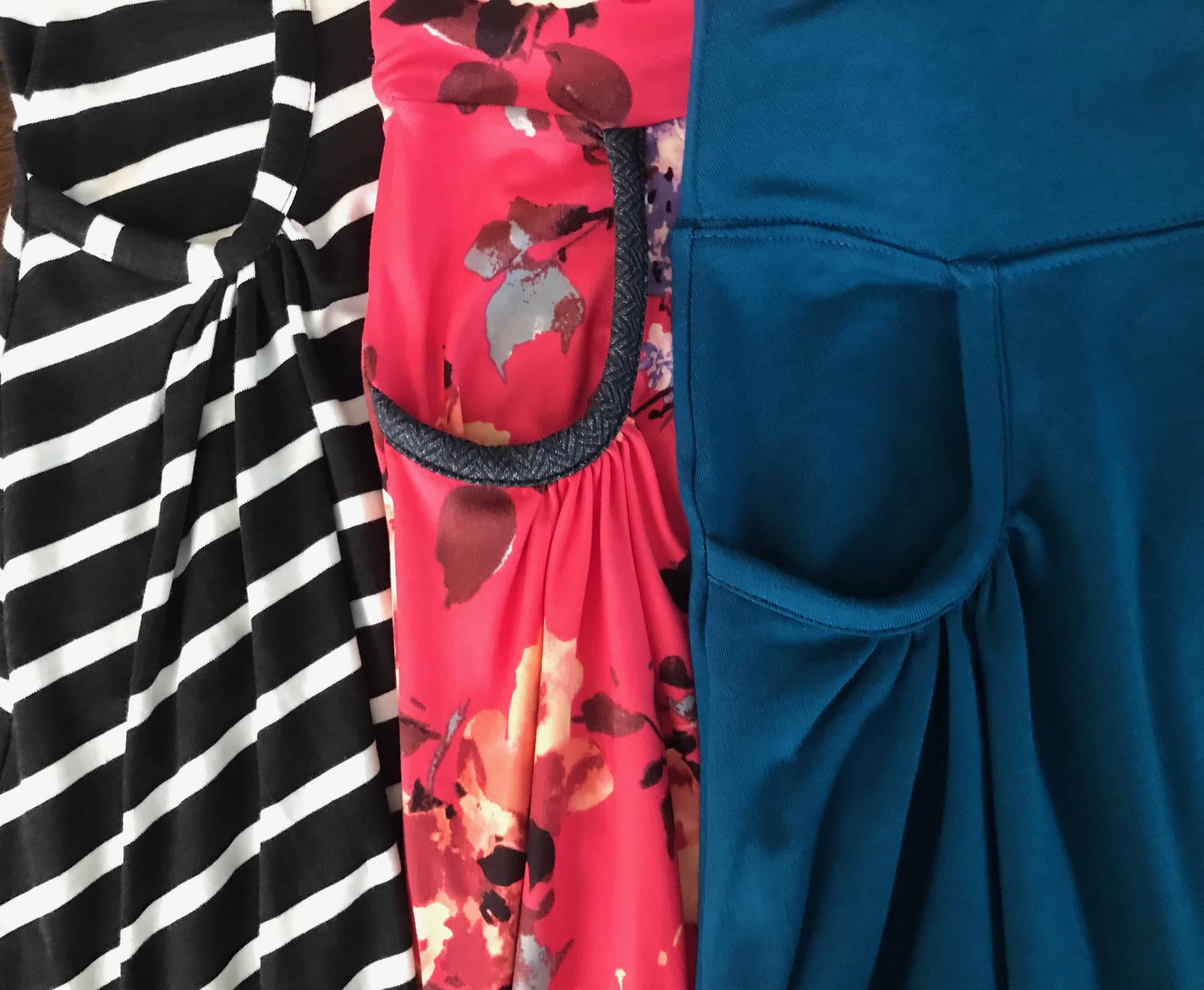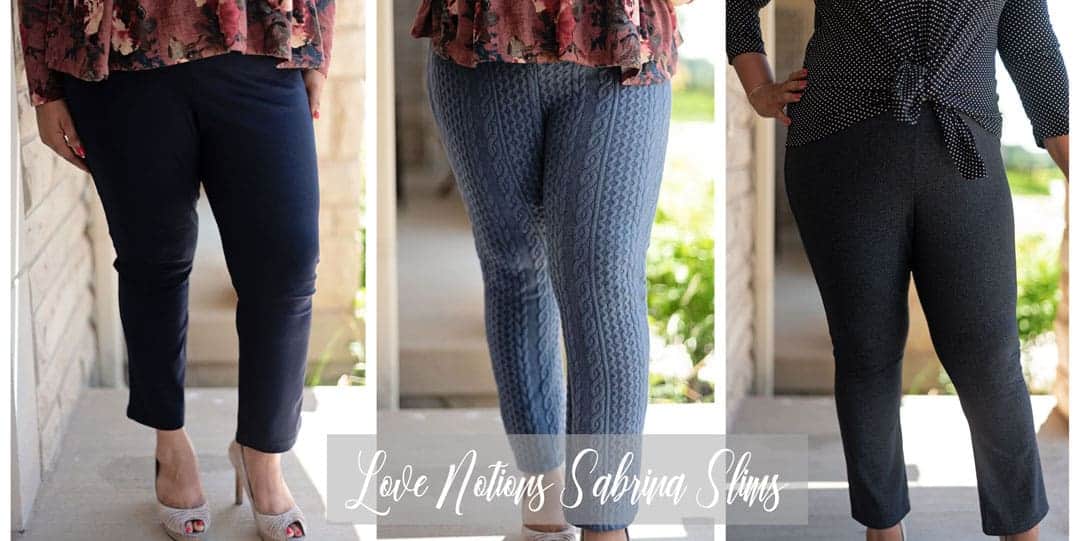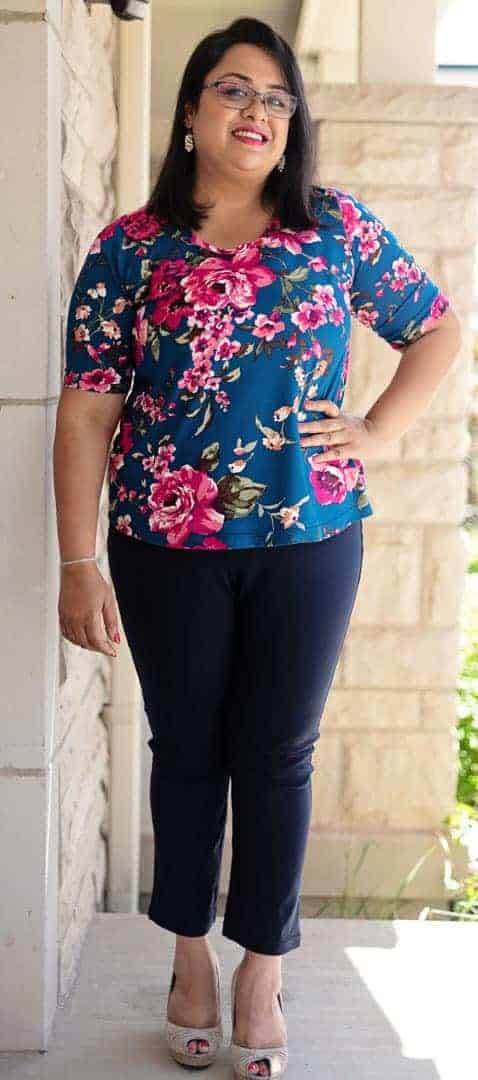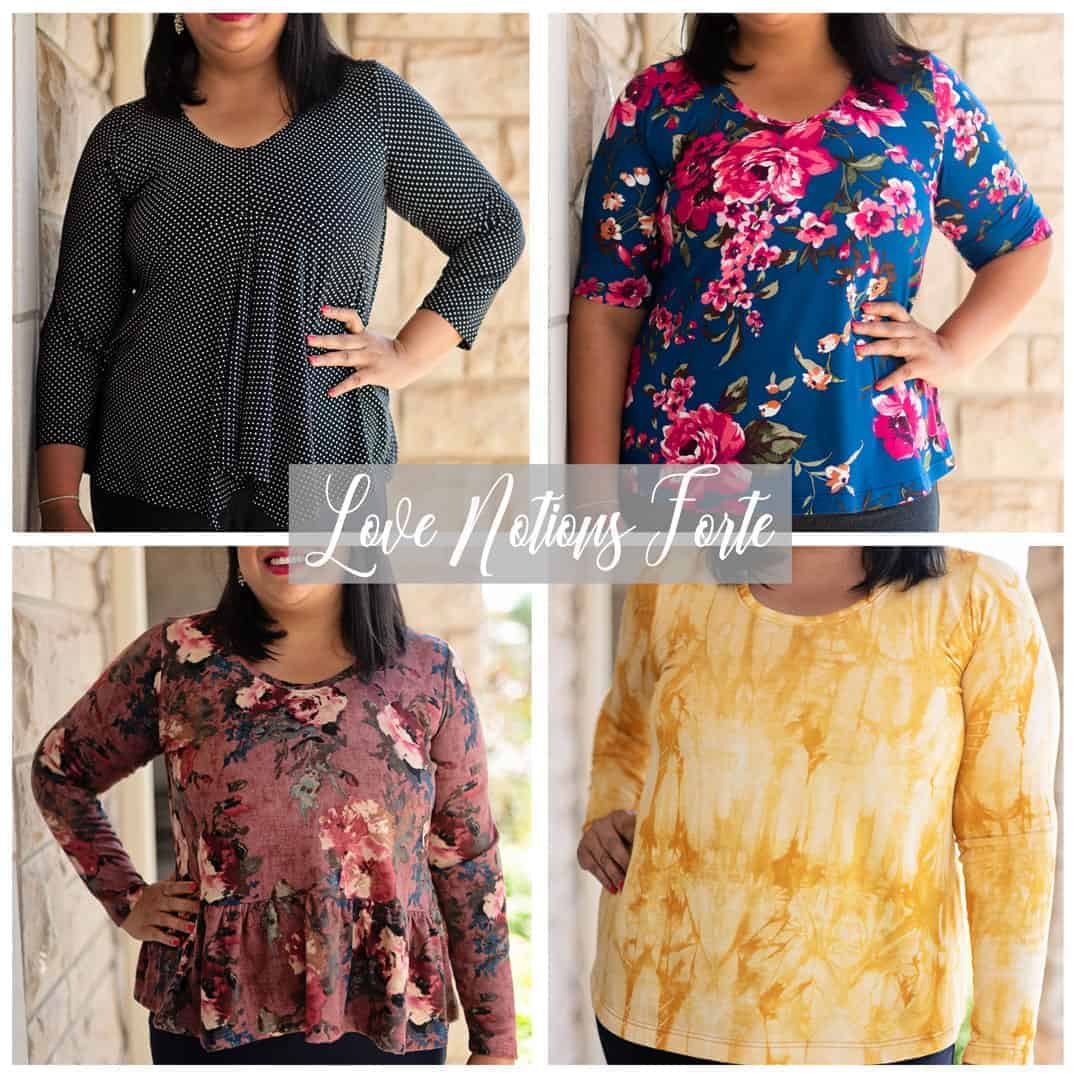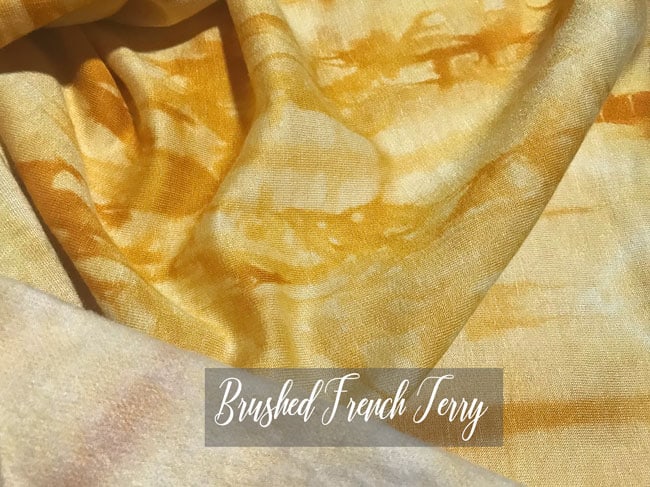It’s almost August, and the kids are heading back to school. You’ve yearned to sew all summer, but the (hopefully) gorgeous weather has put your plans on the back burner. If you’re feeling overwhelmed by the loads of patterns and fabric you’ve accumulated, or perhaps wondered if what you have on hand will suit the pattern you’ve chosen, I’m here today to chat about sewing with intention. I’ll show you a variety of fabrics from Water Tower Textiles, and how they behave when sewn up in three of my favorite Love Notions patterns. By the end of this post you’ll be able to judge whether a particular fabric will give you the look you’re going for – and you’ll be armed with knowledge that will give you great results, time and time again!
CHOOSING A PATTERN
Sewing with intention means making the most of your sewing time, and achieving a garment that will serve you well. When choosing a pattern, there are some basic questions you’ll want to ask yourself.
What does your wardrobe need? A new pair of pants for work? A skirt for a casual party? A “boring” black top instead of all the florals your closet is stuffed with? I’m guilty of that last one, by the way. Choose a pattern that is in harmony with your style. It’s also great to break free and make something that’s totally different from the usual, if that’s what you’re missing. That segues into the next question.
Will what you make pair well with what you already have? I have a closet full of floral print tops – a pair of floral pants, therefore, will not really get worn because I wouldn’t put two floral prints in one outfit. I have, however, paired textures and bright prints, stripes and florals, tiny dots and solids and rarely, analogous colors in an ensemble. Get creative with the clothes you already have!
Is what you’re making appropriate for your climate/lifestyle/personal preferences? If you’re in a hot, humid region, you’re going to want to avoid polyester pants. That Liverpool (also known as jacquard/bullet fabric) you’ve been hoarding will make a great Willow Wrap Dress, but I wouldn’t make the Sabrina Slims pants to avoid swamp-crotch. I just moved from years of living in Texas to Canada – I definitely need more styles that can be layered and worn with snow gear. It’s important to consider your surroundings when planning!
Does the pattern have plenty of options so that you can print once and get more looks from it? This one I put last, because it’s a personal recommendation. Having multiple views in the same pattern is economical, and you don’t need to repeatedly make your standard adjustments. I made 4 Forte tops, 3 Sabrina Slimspants and 3 Ravinia skirts – and got ten garments in 5 days! I did spend plenty of time sewing, but not much in cutting/glueing.
CHOOSING FABRIC
There is a huge variety of fabric available in the market, and with online fabric shopping there’s always a bit of guessing involved. Will it have the requisite stretch? Is the weight of the fabric enough for your project? Water Tower Textiles does a wonderful job of listing the weight, stretch percentage, width of fabric, fiber content and suggested garment styles for each fabric in their well-stocked store. They also sell by the half-metre (and in CAD), so you can get exactly what your project requires. Many fabric stores don’t mention all this information, so sometimes your intention for the fabric you buy changes.
NOTE: Don’t forget to account for shrinkage and print direction/nap. Natural fibers tend to shrink once dried on hot, and to match plaids and stripes you will need extra fabric to place your pattern piece strategically. I personally get a yard extra when sewing for myself. Any excess fabric I then use for kids’ outfits, bands and cuffs of other garments or scrunchies, headbands, wallets and other scrap-busters.
Once you have decided on a fabric, picking an appropriate pattern becomes vital – stretch percentage, recovery, drape, thickness of the fabric, weight, breathability – we’ll talk about all these in the next section. Make sure you read the fabric recommendations listed in the pattern instructions before you begin. While patterns drafted for woven fabric can generally be made in knits if you size down, those drafted for knits will not work with wovens due to lack of wearing ease.
FABRIC AND HOW IT AFFECTS A GARMENT
Water Tower Textiles generously sent me ten fabrics, and I chose the Forte top, the Sabrina Slims pants and the Ravinia Skirt patterns from Love Notions to feature them. I wanted to showcase how the same pattern behaves in a variety of fabric bases and weights. With this experiment, let’s pay special attention to the drape of the fabric, the stiffness and “feel” of the garment, and the folds that form when I stand in various positions.
This week’s featured pattern is the Ravinia Skirt. —- our $5 Feature Friday pattern of the day!! —- I love the gathered pockets and contoured waistband – the silhouette is incredibly flattering because of the placement of the gathers. I decided to make the Ravinia in three fabrics:
- Bamboo Cotton Jersey Medium Stripes, Ivory On Black – 200 gsm, 4 way stretch
- Knottingley Brushed Poly Spandex, PEACH On WATERMELON PINK – 4 way stretch, 180 gsm
- Bamboo Stretch French Terry, Moroccan Blue – 4 way stretch, 270 gsm
I chose to make calf-length skirts instead of the maxi length from the Bamboo bases, since bamboo tends to “grow” as it is worn. I don’t wear knee length skirts, so the calf-length is great. Note that the french terry (blue) is thicker than the jersey (stripe), and so the gathers are more prominent and the skirt is more structured. Both fabrics kept me comfortable in ridiculous humidity, as natural fibers have great breathability. French terry has loops on the wrong side, and is very popular for rompers, sweatshirts, winter hoodies and even cardigans.
I love double brushed poly (watermelon floral) in a maxi skirt. It’s the only way I can wear polyester in the summer without becoming a sweaty mess. Most polyester fabric never fades and has beautiful drape. Double brushed poly feels sueded and warm to the touch on both sides, and is great for maxi dresses like the Summer Basics – any pattern that’s flowy. If you’re sewing for cold weather, it makes great layering tees! Single brushed poly is cool to touch on the wrong side, like ITY fabric, and makes great wrap dresses and flowy pants.
Let’s talk pants next. The Sabrina Slims pattern is my favorite style of pants. I love the slim leg, and optional welt pockets. It’s easy to tuck into boots, and the ankle length looks great with any shoe. I chose three fabrics again:
- Navy Ponte – rayon, nylon, spandex blend – Stretch: approx. 40% horizontal, 20% vertical, 320 gsm
- Cable Jacquard Knit, Blue – 4 way stretch 375 gsm
- Peached Herringbone, Heather Charcoal – 4 way stretch 223 gsm
Navy Pants: Ponte knit is usually either rayon or polyester blended with nylon and spandex. The rayon blend (67% Rayon, 28% Nylon, 5% Spandex) does not pill, and makes excellent pants that survive years. I made the Sabrina Slims from this fabric during testing over three years ago, and they still look like new despite being in heavy rotation. I have large thighs and most jeans and pants wear out at the top of the inseam, but these showed no signs of thinning out. Polyester blend ponte does pill after drying on high, so I am careful while laundering it.
The Cable-knit jacquard is a super thick, heavy fabric, 93% Polyester, 5% Rayon, 2% Spandex. I am super excited to wear these in winter. I want to make a Tessa Sheath dress from this fabric next – and hoodies, cardigans, and more. It has the least amount of drape of the three, and while the thinner fabrics show wrinkles from movement, these pants conformed to my body beautifully.
The herringbone “peached” fabric was just a joy to work with. It’s the lightest of the three, but has a great brushed texture, and is 68% Nylon, 23% Polyester, 9% Spandex. It’s great for leggings, and feels comfortable against the skin.
Looking at the photo above, the ponte pant shows folds and wrinkles, and feels overall looser than the other two. I’d like to note that they were all cut and sewn from the same master pattern (I adjusted for large inner thighs, knock knees and large belly after making a muslin). There is a “cameltoe” in the navy pants, which I will fix by scooping the front curve a little more – there just seems to be extra fabric all over. Surprising how different fabrics behave in the same pattern!
And finally, we come to four versions of the Forte top. I kept the sleeves simple in all my tops, so that I can layer them under jackets and cardigans depending on the weather. The fabrics I used were:
- Mini Dots, Double Brushed Poly Spandex, On BLACK
- Dawley Double Brushed Polyester, Pink On Aegean Blue
- Hacci Brushed Sweater Knit, Painted Floral
- Brushed French Terry, Tie Dye MUSTARD
Dawley, the double brushed poly has great drape, and so looks fabulous in the waterfall option of the Forte. It also looks great as a simple tee, and in the gathered option (not shown here) – with plenty of 4 way stretch, there’s so much you can make!
Hacci sweater knits are, in my opinion, absolutely amazing. They are usually polyester blends, so great for cold weather, and come in a huge variety of prints and solids. There are some hacci knits with a looser weave, but this type has great drape, plenty of stretch and recovery – and looks great when gathered.
The Mustard Brushed French terry is 76% Rayon, 20% Polyester, 3% Spandex, and has only two-way stretch. The vertical stretch is minimal, and so the fit is much closer to the body than the sweater knit version. It has a fleecy, fuzzy brushed wrong side, and is incredibly soft and warm. I think I’m going to live in this one in winter! Note that this fabric retains its shape versus the blue brushed poly, which softly drapes from the bust.
In summation, choosing fabric is as vital as choosing your pattern for a finished garment you’ll love forever. Consider the attributes of the fabric carefully, and when in doubt, make a test garment or muslin from a fabric that is similar in drape and weight and stretch as your final fabric. If you find your fabric stash doesn’t have the qualities you’re looking for, Water Tower Textiles has an incredible variety of bases in gorgeous colors and prints. You’re sure to find something you’ll love, and you can *SAVE* too! In my next article (mid August), I’ll show you how to combine colors and prints, and how I planned a mini-capsule from these ten pieces. I’ll also talk about breaking out of your box of usual colors, and experimenting with something new.


